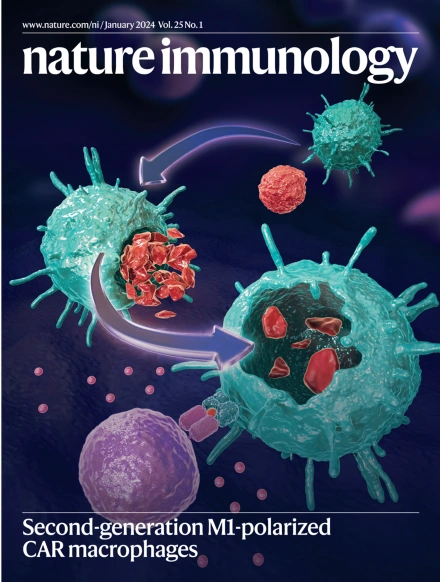Restriction of innate Tγδ17 cell plasticity by an AP-1 regulatory axis
IF 27.6
1区 医学
Q1 IMMUNOLOGY
引用次数: 0
Abstract
Interleukin-17 (IL-17)-producing γδ T (Tγδ17) cells are innate-like mediators of intestinal barrier immunity. Although IL-17-producing helper T cell and group 3 innate lymphoid cell plasticity have been extensively studied, the mechanisms governing Tγδ17 cell effector flexibility remain undefined. Here, we combined type 3 fate mapping with single-cell ATAC-sequencing/RNA-sequencing multiome profiling to define the cellular features and regulatory networks underlying Tγδ17 cell plasticity. During homeostasis, Tγδ17 cell effector identity was stable across tissues, including for intestinal T-bet+ Tγδ17 cells that restrained interferon-γ production. However, Salmonella enterica subsp. enterica serovar Typhimurium infection induced intestinal Vγ6+ Tγδ17 cell conversion into type 1 effectors, with loss of IL-17A production and partial RORγt downregulation. Multiome analysis revealed a trajectory along Vγ6+ Tγδ17 cell effector conversion, with TIM-3 marking ex-Tγδ17 cells with enhanced type 1 functionality. Last, we characterized and validated a critical AP-1 regulatory axis centered around JUNB and FOSL2 that controls Vγ6+ Tγδ17 cell plasticity by stabilizing type 3 identity and restricting type 1 effector conversion. Ciofani and colleagues examine the plasticity of Tγδ17 cells in the gut, where they identify a role for the AP-1 transcription factors JUNB and FOSL2 in restricting type 1 plasticity.

AP-1调控轴对先天t - γδ17细胞可塑性的限制
产生白细胞介素-17 (IL-17)的γδ T (Tγδ17)细胞是肠道屏障免疫的先天样介质。虽然产生il -17的辅助性T细胞和3组先天淋巴样细胞的可塑性已经被广泛研究,但控制T - γδ17细胞效应灵活性的机制仍然不明确。在这里,我们将3型命运图谱与单细胞atac测序/ rna测序多组分析相结合,以确定t - γδ17细胞可塑性的细胞特征和调控网络。在体内平衡过程中,Tγδ17细胞效应物在组织间是稳定的,包括肠道T-bet+ Tγδ17细胞,它们抑制干扰素-γ的产生。然而,肠道沙门氏菌亚种。肠炎鼠伤寒杆菌感染诱导肠道Vγ6+ Tγδ17细胞转化为1型效应体,IL-17A产生减少,部分rr γt下调。多组分析显示沿v - γ6+ t - γδ17细胞效应转化的轨迹,TIM-3标记前t - γδ17细胞具有增强的1型功能。最后,我们鉴定并验证了以JUNB和FOSL2为中心的关键AP-1调节轴,该轴通过稳定3型身份和限制1型效应物转换来控制v - γ6+ t - γδ17细胞的可塑性。
本文章由计算机程序翻译,如有差异,请以英文原文为准。
求助全文
约1分钟内获得全文
求助全文
来源期刊

Nature Immunology
医学-免疫学
CiteScore
40.00
自引率
2.30%
发文量
248
审稿时长
4-8 weeks
期刊介绍:
Nature Immunology is a monthly journal that publishes the highest quality research in all areas of immunology. The editorial decisions are made by a team of full-time professional editors. The journal prioritizes work that provides translational and/or fundamental insight into the workings of the immune system. It covers a wide range of topics including innate immunity and inflammation, development, immune receptors, signaling and apoptosis, antigen presentation, gene regulation and recombination, cellular and systemic immunity, vaccines, immune tolerance, autoimmunity, tumor immunology, and microbial immunopathology. In addition to publishing significant original research, Nature Immunology also includes comments, News and Views, research highlights, matters arising from readers, and reviews of the literature. The journal serves as a major conduit of top-quality information for the immunology community.
 求助内容:
求助内容: 应助结果提醒方式:
应助结果提醒方式:


